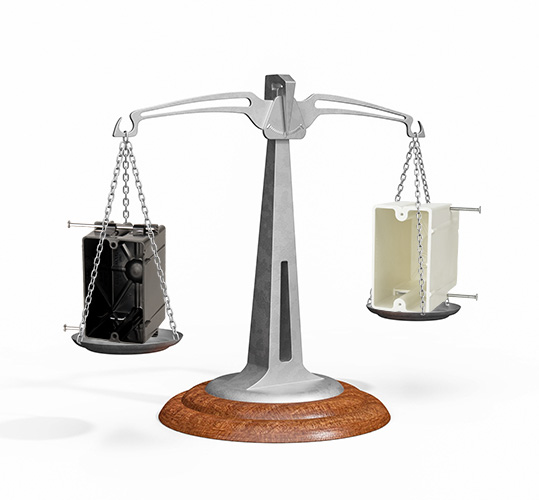
When a contractor considers a project, they have to think about all of the materials they will need to complete the work. There are a lot of items on their checklist, and one that some might overlook is electrical boxes.
Electrical boxes hold wires and electrical components to keep them safe, prevent fire hazards and create a mounting fixture for the device. There are various sizes and configurations for electrical boxes and a certified electrical contractor will know which boxes are right for your project.
So, how do contractors choose the right box? While there are many factors that play a part in the final electrical plan, these points are a good starting point.
Location and Code
A certified electrical contractor will know the latest building codes for your area. They will pick materials and install the boxes to the latest electrical codes. They will also choose boxes that will pass inspection, such as electrical boxes that have vapor and air sealing properties for the exterior walls of an energy efficient home, or fan boxes that can support the weight of a moving ceiling fan.
You should also make sure that the electrical boxes you are installing will fit GFCI and “smart” or wifi enabled devices.
Pick the Right Material
Along with location and code a contractor will think about the material that the box is made out of. For the most part, you can get metal or nonmetal boxes. While there are applications where metal boxes make sense, non metal electrical boxes have become the go-to for contractors in recent years.
Nonmetal boxes can be made from plastic formulations or fiberglass. Each carries its own benefits like the metal boxes. Plastic electrical boxes are lightweight, available in most big box retail stores, and most of the time, cost effective. But their drawbacks can include being brittle when in cold climates, warping when installed on warped wall studs, and require the use of a costly putty pad. Fiberglass electrical boxes are sturdy like metal boxes, don’t require a putty pad to meet the 2-hour fire rating, and hold their shape on any wall stud. They are also the go-to electrical box for multi-family housing because you can place two boxes in the same wall cavity.
Consider the Size and Shape
When the material is selected, the next thing the contractor will think about is the size of the box. An electrical box needs to be large enough to hold the electrical components without overheating. With more houses utilizing smart devices, electrical boxes are becoming more cramped so knowing the plan for a smart home from the beginning can save a lot of time and money.
The shape of the box matters too. They are shaped so that they can hold the correct device components and create a mounting surface for wall or ceiling fixtures. Depending on the device you plan to install, you may require a square, rectangle, or round electrical box.
Determine the Need for Adjustable Boxes
The last major thing to consider is adjustability. Adjustable electrical boxes are a specific kind of box that can be moved a little bit after it is installed. Most commonly, these are boxes that are installed in walls for kitchen, bathrooms, and exterior walls where the finished wall surface may still need to be added. The depth of the box is adjusted by turning a screw. The point is that the box can change its depth to match different finishes on a wall.
Most boxes are installed behind drywall. Drywall comes in standard thicknesses, so you don’t really need the adjustability of these specialized boxes. These adjustable electrical boxes are becoming more popular with electrical contractors as it is easier for the box to adjust after the wall tile, stone, wood, etc. is added.
Looking to stay up-to-date on the latest articles and product releases? Don’t miss out – sign up below and be the first to know!
